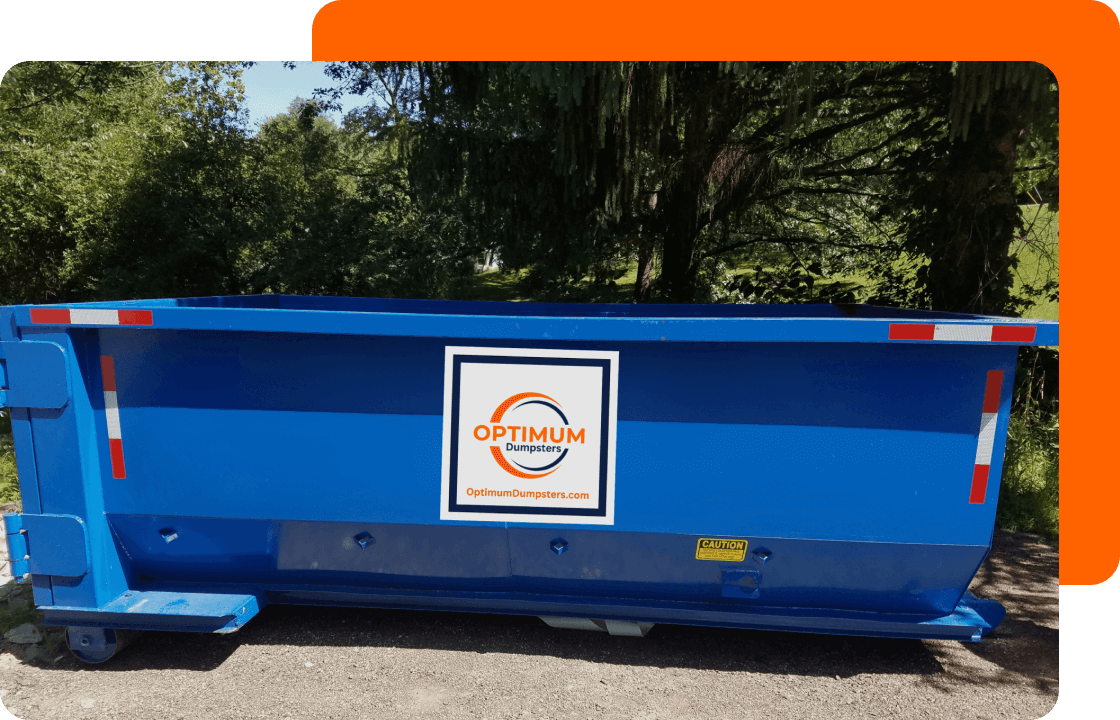Optimum Dumpster Debris Weight Guide
Debris Weight Guide
While your debris may fit within the volume of the container you rent, the weight of your debris can exceed the dumpster’s weight limit. For example, a 10 yard dumpster filled with tree branches will weigh less than the same dumpster filled with broken concrete. This means you can only partially fill specific dumpster sizes with those heavier materials to stay within the weight limit. Landfills charge disposal costs by the ton. Exceeding the dumpster’s weight limit will result in a per-ton overage fee. Always consider the type and weight of your materials when choosing a dumpster.
On average, a cubic yard of solid concrete weighs 4,050 pounds (~2 tons), or 150 pounds per cubic foot. Solid asphalt weighs slightly less at 3,960 pounds per cubic yard. We base concrete and asphalt weights on the square footage and thickness of the material. Broken concrete and asphalt weigh closer to 2,025 pounds (~1 ton) per cubic yard, or 75 pounds per cubic foot, when disposed of in a dumpster because of the extra empty space.
You can estimate the weight of shingles in squares or bundles. Generally, three bundles of asphalt shingles are enough to cover one roofing square (100 square feet). A bundle of three-tab asphalt shingles weighs between 60 pounds and 80 pounds. A square weighs between 180 pounds and 240 pounds. Shingle weights will vary depending on the quality and type of shingle. If you’re removing architectural shingles, they will weigh between 70 pounds and 80 pounds per bundle. Slate shingles weigh much more, between 250 pounds and 350 pounds per bundle.
A single sheet of 4 feet by 8 feet, half-inch thick drywall weighs nearly 50 pounds. Calculate the weight of drywall, sheetrock and plaster using the square footage of debris and the thickness of the material.
Carpet can weigh anywhere from 5 pounds to 20 pounds per square yard or 0.5 pounds to 2.2 pounds per square foot. The weight of your carpet will vary based on the material and thickness.
Pro-Tip for Carpet and Absorbent Materials:
Carpet and other absorbent materials, such as dirt and upholstered furniture, become heavier when wet. This adds excess weight to your roll off container. If it rains during your rental period, cover your bin with a tarp secured with bungee cords or straps to prevent those absorbent materials from soaking up the water.
The truck drives onto a scale at the disposal facility where an initial weight is recorded (gross weight). The truck then empties the contents of the dumpster. Next, the truck darives onto a second scale that records the weight of the truck and the empty dumpster (tare weight). The difference between the first and second weights (gross – tare) is the weight of the debris in the dumpster. The scales are regulated by state bureaus of weights and measures.

Debris | Weight (lbs) per Cubic Yard | Weight (tons) per Cubic Yard |
|---|---|---|
Bricks |
2,500 – 3,500 |
1.25 – 1.75 |
Concrete & Asphalt |
3,500 – 4,200 |
1.75 – 2.1 |
Dirt |
2,000 – 3,000 |
1 – 1.5 |
Drywall |
500 – 750 |
.25 – .375 |
General Household Debris |
150 – 400 |
.075 – .2 |
Sand |
3,000 – 3,200 |
1.5 – 1.6 |
Shingles (asphalt) |
2,400 – 2,600 |
1.2 – 1.3 |
Shingles (slate) |
9,000 – 10,000 |
4.5 – 5 |
Stone |
2,600 – 2,800 |
1.3 – 1.4 |
Wood |
300 – 500 |
.15 – .25 |
Yard Waste (no dirt) |
400 – 700 |
.2 – .35 |
To help estimate the weight of the contents of your dumpster, please refer to the list of common debris types and their accompanying weights per cubic yard.
| Debris | Weight (lbs) per Cubic Yard | Weight (tons) per Cubic Yard |
|---|---|---|
| Bricks | 2,500 – 3,500 | 1.25 – 1.75 |
| Concrete & Asphalt | 3,500 – 4,200 | 1.75 – 2.1 |
| Dirt | 2,000 – 3,000 | 1 – 1.5 |
| Drywall | 500 – 750 | .25 – .375 |
| General Household Debris | 150 – 400 | .075 – .2 |
| Sand | 3,000 – 3,200 | 1.5 – 1.6 |
| Shingles (asphalt) | 2,400 – 2,600 | 1.2 – 1.3 |
| Shingles (slate) | 9,000 – 10,000 | 4.5 – 5 |
| Stone | 2,600 – 2,800 | 1.3 – 1.4 |
| Wood | 300 – 500 | .15 – .25 |
| Yard Waste (no dirt) | 400 – 700 | .2 – .35 |
